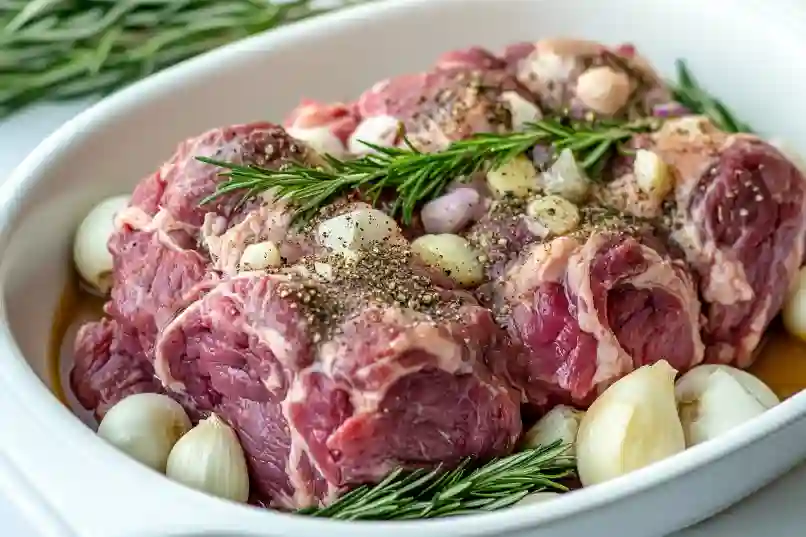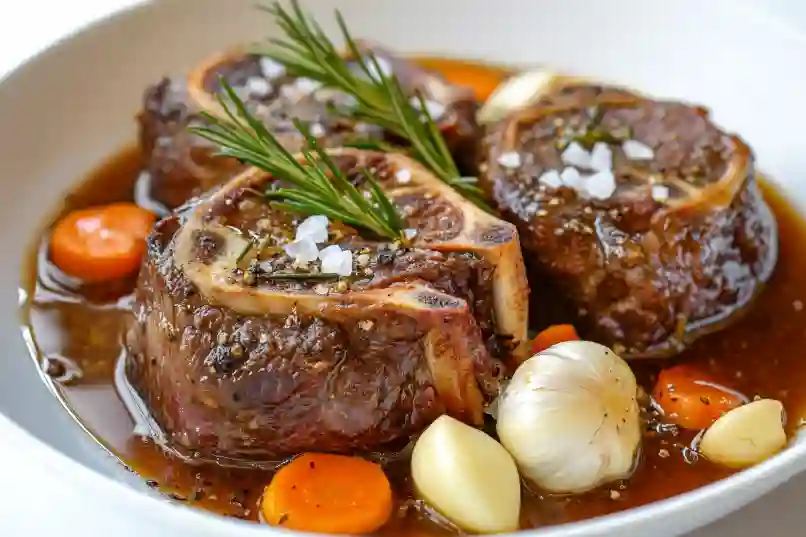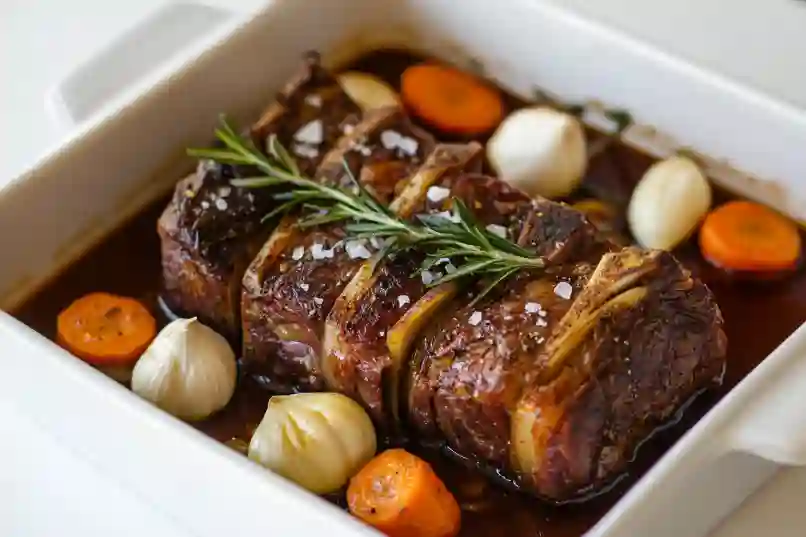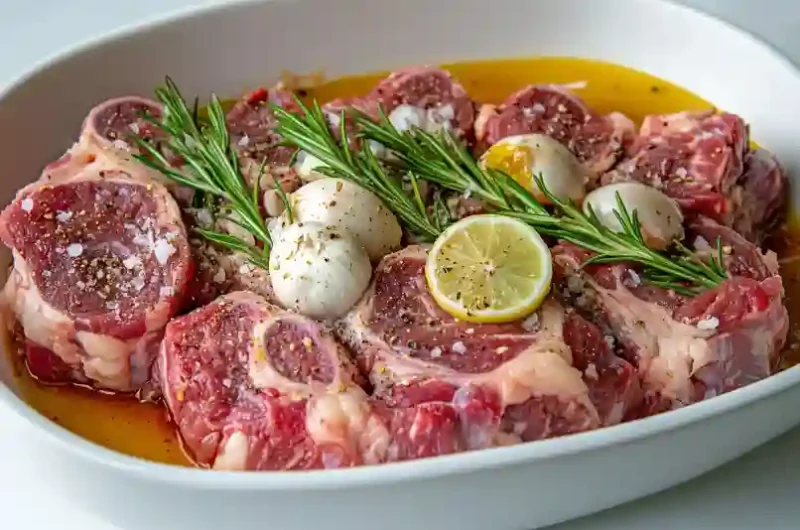Boost post-workout healing with this collagen-rich beef knuckle stew. Learn to cook it right for better joint support, protein intake, and recovery.
When you’re sore, drained, or somewhere in between a max-out deadlift and your next protein shake, the last thing you want is another dry chicken breast. What your body craves no, what it needs is deep, nourishing fuel. Enter: beef knuckle. A cut that rarely gets top-billing, but quietly packs a punch in protein, collagen, and slow-cooked recovery magic.
In fitness circles, we talk a lot about macros, mobility, even mindset. But what about muscle restoration at the cellular level? That’s where this recipe leans in. Beef knuckle, when cooked right, becomes a gelatin-rich, amino-loaded, inflammation-soothing powerhouse. It’s not just food it’s strategy.
In this guide, you’ll learn exactly how to transform this tough, inexpensive cut into a meal that actively supports your body’s rebuilding process. Whether you’re bouncing back from an intense workout or just chasing longevity with better eating, this slow-cooked dish is your under-the-radar ally.
So, let’s break it down step-by-step into a recovery ritual your body (and taste buds) will thank you for.
How to Cook a Beef Knuckle for Muscle Recovery
Course: Blog6
servings20
minutes3
hours~320 kcal (varies by cut and fat content)
kcalSlow-cooked beef knuckle stew packed with collagen, perfect for post-workout muscle recovery.
Ingredients
2.5 to 3 lbs beef knuckle (bone-in preferred)
1 tbsp olive oil or avocado oil
1 large onion, chopped
4 cloves garlic, minced
2 medium carrots, chopped
2 stalks celery, sliced
1 tbsp fresh grated ginger
1 tsp turmeric powder
Pinch of black pepper
1 tsp dried thyme (or 1 tbsp fresh)
1 bay leaf
6–8 cups filtered water or beef bone broth
Sea salt and cracked black pepper, to taste
Optional:
1 tbsp apple cider vinegar
Handful chopped parsley (for garnish)
Directions
- Season the beef knuckle with salt and pepper.
- (Optional) Sear in a skillet over medium-high heat until browned on all sides
- In the same pot or slow cooker insert, sauté onion, garlic, carrots, and celery for 5–7 minutes.
- Add ginger, turmeric, thyme, and black pepper; cook 1–2 more minutes.
- Transfer everything to a slow cooker or Dutch oven.
- Add beef knuckle, bay leaf, and water or broth to cover. Add apple cider vinegar if using.
- Cook:
Slow Cooker: Low for 8 hours or High for 5–6 hours
Stovetop: Simmer on low for 3 hours, skimming foam if needed - Remove beef, shred with forks, and discard bones.
- Strain broth if desired. Return shredded meat to pot.
- Adjust seasoning and serve hot, garnished with parsley.
Table of Contents
Ingredients for Cooking Beef Knuckle
Every item in this recipe has a purpose not just for flavor, but for function. Here’s what you’ll need to turn a humble beef knuckle into a recovery powerhouse:

- 2.5 to 3 lbs beef knuckle (bone-in, if possible)
Rich in collagen, marrow, and slow-release amino acids - 1 tablespoon olive oil or avocado oil
Helps in the absorption of fat-soluble nutrients - 1 large onion, chopped
Natural source of prebiotics, supports gut health - 4 cloves garlic, minced
Anti-inflammatory and immune-supportive - 2 medium carrots, chopped
Adds natural sweetness and beta carotene - 2 stalks celery, sliced
Hydration and electrolyte balance - 1 tablespoon fresh grated ginger
Anti-inflammatory and gut-calming - 1 teaspoon turmeric powder + pinch of black pepper
Curcumin + piperine combo enhances absorption and reduces soreness - 1 teaspoon dried thyme or 1 tablespoon fresh
Mild antimicrobial and aromatic balance - 1 bay leaf
- 6–8 cups filtered water or homemade bone broth
Hydration and mineral base for deep muscle support - Sea salt and cracked black pepper to taste
Optional Add-ins:
- 1 tablespoon apple cider vinegar
Helps extract minerals from bones - Handful of chopped parsley (for garnish)
Vitamin K and a bright finish
FAQ: Can I use beef knuckle without the bone?
Yes, but you’ll lose some of the gelatin and marrow benefits. If using boneless, consider adding grass-fed gelatin or a collagen supplement into the final broth for a similar effect.
Instructions : How to Cook Beef Knuckle
1. Prep the Beef Knuckle
- If using a whole bone-in knuckle, pat it dry and season it generously with salt and pepper.
- Optionally, cut into large chunks for faster cooking and more surface area.

2. Sear for Depth (Optional but Recommended)
- Heat oil in a large skillet over medium-high heat.
- Sear beef knuckle pieces until browned on all sides (about 2–3 minutes per side).
Why? This adds Maillard-reaction richness to the broth a flavor boost you’ll feel.
3. Build the Flavor Base
- In the same skillet or your slow cooker insert, sauté onion, garlic, carrots, and celery for 5–7 minutes until softened and fragrant.
- Stir in turmeric, ginger, thyme, and black pepper. Cook another 1–2 minutes to bloom the spices.
4. Combine and Cook
- Transfer everything to a slow cooker or Dutch oven.
- Add the beef knuckle, bay leaf, and enough water or broth to fully cover the ingredients.
- Add apple cider vinegar, if using.
Cooking Options:
- Slow Cooker: Low for 8 hours or High for 5–6 hours
- Stovetop: Simmer gently on low heat for 2.5 to 3.5 hours, skimming foam as needed
5. Shred, Strain, and Serve
- Remove knuckle pieces and shred meat with forks. Discard bones (or save them for bone broth).
- Strain the broth if desired for a cleaner finish.
- Return shredded meat to the pot. Taste and adjust salt as needed.
6. Garnish and Enjoy
- Ladle into bowls and top with parsley or a squeeze of lemon if desired.
- Serve solo or over a base of quinoa, cauliflower rice, or mashed sweet potatoes for added carbs.
H3: FAQ What if I don’t have a slow cooker?
No problem. A Dutch oven or heavy-bottomed soup pot works well just keep the temperature low and steady, and check the liquid every hour to prevent drying out.
Cooking Tips for Muscle Recovery Benefits
Cooking beef knuckle isn’t just about tenderness it’s about coaxing out compounds that actively support recovery. Below are strategic tips that make this more than a meal it becomes part of your comeback routine.

Why Slow Cooking Wins
Muscle recovery requires more than just grams of protein. The connective tissues in beef knuckle are loaded with collagen, gelatin, and glycine compounds that only release through long, slow heat. These amino acids support:
- Tissue repair (especially ligaments, tendons, and cartilage)
- Joint hydration via improved synovial fluid
- Deeper sleep cycles, thanks to glycine’s calming effect
TL;DR: Low and slow unlocks recovery potential your whey protein shake can’t touch.
Don’t Skip the Acid
Adding apple cider vinegar helps pull minerals from the bones and connective tissue. It enhances the broth’s calcium, magnesium, and phosphorus content all crucial for muscle contraction and post-lift recovery.
Searing Is Optional But Powerful
While it doesn’t affect recovery directly, searing your meat creates flavor complexity. The richer the flavor, the more likely you are to eat it often — and that’s half the battle when building a sustainable post-training diet.
Boost with Herbs that Heal
- Turmeric + black pepper = anti-inflammatory synergy
- Ginger = gut-soothing, immune-supportive
- Parsley = natural detoxifier with vitamin K
They’re not garnish. They’re your support squad.
H3: FAQ – Is gelatin really helpful for sore muscles?
Yes. Gelatin provides glycine and proline two amino acids that support soft tissue repair and reduce inflammation. Studies even suggest collagen-rich meals can improve joint pain and recovery times, especially when paired with strength training.
Variations for Dietary Needs
Whether you’re tracking macros like a hawk or just trying to avoid bloating, here’s how to adapt this beef knuckle stew for your specific nutritional style without losing the recovery benefits.
Keto & Low-Carb Adjustments
- Skip the carrots or replace with zucchini or daikon radish to lower the glycemic load.
- Use bone broth instead of water for added fats and electrolytes.
- Add a swirl of MCT oil or grass-fed butter before serving for a fat-fueled finish.
Low-Sodium Version
- Choose unsalted broth and limit added salt up front.
- Amp up flavor with fresh herbs, lemon zest, and ginger instead of salt-based seasonings.
- Let individuals salt their bowl to taste after serving.
High-Collagen Upgrade
- Add extra beef bones or ox tail to the pot for a denser, richer broth.
- Drop in 2 tablespoons of grass-fed beef gelatin or collagen peptides in the final 10 minutes of cooking.
Anti-Inflammatory Tweaks
- Add 1 tsp ground cinnamon or a small piece of dried reishi mushroom during simmering.
- Finish with a squeeze of lemon juice and a handful of fresh cilantro.
Serving Style Swaps
- Serve over mashed cauliflower for a creamy, low-carb base.
- Pair with wild rice or sweet potato for complex carb replenishment after intense workouts.
H3: FAQ – Can I freeze the stew for meal prep?
Absolutely. In fact, it freezes beautifully. Portion into airtight containers and freeze for up to 3 months. Reheat gently to preserve collagen texture don’t blast it in the microwave or you’ll lose the magic.
FAQ About Cooking Beef Knuckle for Recovery
H3: Is beef knuckle really better for recovery than leaner cuts?
Yes for certain goals. While leaner cuts like sirloin offer pure protein, beef knuckle brings collagen, gelatin, and marrow, which support joint repair, inflammation reduction, and gut health. Think of it as a different recovery tool one focused on deep tissue rebuilding, not just protein grams.
H3: Can I cook this in an Instant Pot?
Definitely. Use the sauté setting for browning and aromatics, then pressure cook on High for about 50–60 minutes with natural release. It’s faster, and still breaks down the collagen-rich tissue well.
H3: Will it taste too “beefy” or gamey?
Not if cooked right. Using aromatics like ginger, garlic, and turmeric balances out the richness. And if you’re sensitive to strong meat flavors, opt for boneless beef knuckle and add citrus or fresh herbs at the end.
H3: What’s the difference between beef knuckle and shank?
Beef knuckle is leaner with large connective tissue pockets (great for gelatin), while shank includes bone and marrow by default. Both work, but knuckle offers a slightly cleaner texture and more shreddable meat.
H3: How often should I eat this for recovery?
That depends on your training volume. 2–3 servings per week can support joint integrity, gut health, and connective tissue repair especially if you’re doing heavy lifting, HIIT, or endurance training.
H3: Why It Works for Recovery
- Slow-cooking releases collagen & gelatin essential for repairing tendons, joints, and cartilage.
- Amino acids like glycine support deep sleep and gut health.
- Apple cider vinegar boosts mineral absorption (think calcium, magnesium).
- Turmeric + black pepper and ginger bring anti-inflammatory benefits.
- Parsley or citrus adds freshness and vitamin support
Nutritional Breakdown
Research shows that collagen-derived amino acids like glycine and proline found in slow‑cooked beef knuckle can amplify muscle strength and recovery after training
When it comes to recovery, not all calories are created equal. This stew delivers more than warmth it offers a full spectrum of micronutrients and aminos that support healing, repair, and performance. Here’s the breakdown based on a standard 4–6 oz serving with broth and vegetables:
Macronutrients (per serving)
- Calories: ~320 kcal
- Protein: 28–32g
- Fat: 12–15g (mostly from connective tissue and marrow)
- Carbohydrates: 6–10g (varies with veggie content)
Collagen & Connective Tissue Compounds
- Gelatin (Type I & III collagen) supports tendon, ligament, and joint repair
- Glycine (2–3g per serving) improves sleep, digestion, and anti-inflammatory response
- Proline & Hydroxyproline help form new connective tissue
Micronutrients & Recovery Benefits
- Iron: Supports oxygen transport and reduces post-workout fatigue
- Zinc: Immune repair and protein synthesis
- Magnesium: Crucial for muscle relaxation and cramp prevention
- Potassium: Replenishes electrolytes lost in sweat
- Vitamin B12: Essential for red blood cell production and nerve recovery
Anti-Inflammatory Add-ons
- Turmeric (curcumin): Natural COX-2 inhibitor
- Ginger: Soothes gut lining and lowers systemic inflammation
- Parsley: Aids in detoxification, rich in vitamin K and folate
H3: FAQ – Is the fat content too high for a lean diet?
Not necessarily. Much of the fat comes from collagen-rich tissue, not pure lipids. It’s nutrient-dense and satiating. If you’re on a cut, simply skim excess fat off the top after chilling the stew collagen will stay, but fat will solidify and can be removed easily.
Recovery isn’t just a rest day. It’s a ritual. A chance to feed the effort you already put in, to rebuild the fibers you pushed past their limits, and to support a body that’s learning to come back stronger. And somehow, in a world of overhyped powders and neon-colored drinks, this humble bowl of slow-cooked beef knuckle might just be the most honest recovery tool you’ve got.
It doesn’t shout. It restores.
So whether you’re healing from a brutal squat session or simply investing in long-game longevity, this dish is more than food it’s functional recovery in a bowl. Try it once, and it might just become your new post-training habit.
Hungry for more? Print, save, or share this recipe with someone else chasing better recovery, one bite at a time.
Looking for more Lunch ideas? Check out some of our other reader favorites:
High-Protein Grilled Chicken Quinoa Bowl for Post-Workout Recovery
This recipe ( How to Cook a Beef Knuckle for Muscle Recovery) is intended for informational and meal-planning purposes only. Nutritional values are estimated based on standard ingredient brands and serving sizes; actual values may vary. Always consult with a registered dietitian or healthcare professional before making significant changes to your diet, especially if you have underlying health conditions or specific fitness goals. This meal is not intended to diagnose, treat, or cure any medical condition


